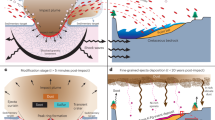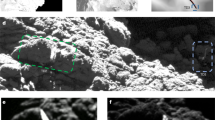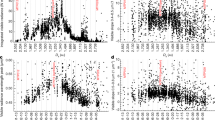Abstract
Comets evolve due to sublimation of ices embedded inside porous dust, triggering dust emission (that is, erosion) followed by mass loss, mass redistribution and surface modifications. Surface changes were revealed by the Deep Impact and Stardust NExT missions for comet 9P/Tempel 1 (ref. 1), and a full inventory of the processes modifying cometary nuclei was provided by Rosetta while it escorted comet 67P/Churyumov–Gerasimenko for approximately two years2,3,4. Such observations also showed puzzling water-ice-rich spots that stood out as patches optically brighter and spectrally bluer than the average cometary surface5,6,7,8,9. These are up to tens of metres large and indicate macroscopic compositional dishomogeneities apparently in contrast with the structural homogeneity above centimetre scales of pebble-made nuclei10. Here we show that the occurrence of blue patches determines the seasonal variability of the nucleus colour4,11,12 and gives insight into the internal structure of comets. We define a new model that links the centimetre-sized pebbles composing the nucleus10 and driving cometary activity13,14 to metre-sized water-ice-enriched blocks embedded in a drier matrix. The emergence of blue patches is due to the matrix erosion driven by CO2-ice sublimation that exposes the water-ice-enriched blocks, which in turn are eroded by water-ice sublimation when exposed to sunlight. Our model explains the observed seasonal evolution of the nucleus and reconciles the available data at micro (sub-centimetre) and macro (metre) scales.
This is a preview of subscription content, access via your institution
Access options
Access Nature and 54 other Nature Portfolio journals
Get Nature+, our best-value online-access subscription
$29.99 / 30 days
cancel any time
Subscribe to this journal
Receive 12 digital issues and online access to articles
$119.00 per year
only $9.92 per issue
Buy this article
- Purchase on Springer Link
- Instant access to full article PDF
Prices may be subject to local taxes which are calculated during checkout




Similar content being viewed by others
Data availability
The VIRTIS calibrated data are publicly available through the European Space Agency’s Planetary Science Archive website (https://archives.esac.esa.int/psa/). Source data are provided with this paper.
Code availability
The computer code used to produce VIS spectral-slope maps of 67P is a direct implementation of a published method11. The computer codes used to perform spectral modelling and simulations of the BP fraction temporal evolution are direct implementations of the models described in the present paper.
References
Veverka, J. et al. Return to comet Tempel 1: overview of stardust-NExT results. Icarus 222, 424–435 (2013).
Groussin, O. et al. Temporal morphological changes in the Imhotep region of comet 67P/Churyumov-Gerasimenko. Astron. Astrophys. 583, A36 (2015).
El-Maarry, M. R. et al. Surface changes on comet 67P/Churyumov-Gerasimenko suggest a more active past. Science 355, 1392–1395 (2017).
Fornasier, S. et al. Rosetta’s comet 67P/Churyumov-Gerasimenko sheds its dusty mantle to reveal its icy nature. Science 354, 1566–1570 (2016).
Sunshine, J. M. et al. Exposed water ice deposits on the surface of comet 9P/Tempel 1. Science 311, 1453–1455 (2006).
Filacchione, G. et al. Exposed water ice on the nucleus of comet 67P/Churyumov–Gerasimenko. Nature 529, 368–372 (2016).
Raponi, A. et al. The temporal evolution of exposed water ice-rich areas on the surface of 67P/Churyumov-Gerasimenko: spectral analysis. Mon. Not. R. Astron. Soc. 462, S476–S490 (2016).
Barucci, M. A. et al. Detection of exposed H2O ice on the nucleus of comet 67P/Churyumov-Gerasimenko as observed by Rosetta OSIRIS and VIRTIS instruments. Astron. Astrophys. 595, A102 (2016).
Oklay, N. et al. Long-term survival of surface water ice on comet 67P. Mon. Not. R. Astron. Soc. 469, S582–S597 (2017).
Blum, J. et al. Evidence for the formation of comet 67P/Churyumov-Gerasimenko through gravitational collapse of a bound clump of pebbles. Mon. Not. R. Astron. Soc. 469, S755–S773 (2017).
Ciarniello, M. et al. The global surface composition of 67P/Churyumov-Gerasimenko nucleus by Rosetta/VIRTIS. II) Diurnal and seasonal variability. Mon. Not. R. Astron. Soc. 462, S443–S458 (2016).
Filacchione, G. et al. An orbital water-ice cycle on comet 67P from colour changes. Nature 578, 49–52 (2020).
Fulle, M. et al. How comets work: nucleus erosion versus dehydration. Mon. Not. R. Astron. Soc. 493, 4039–4044 (2020).
Gundlach, B., Fulle, M. & Blum, J. On the activity of comets: understanding the gas and dust emission from comet 67/Churyumov-Gerasimenko’s south-pole region during perihelion. Mon. Not. R. Astron. Soc. 493, 3690–3715 (2020).
Coradini, A. et al. Virtis: an imaging spectrometer for the Rosetta mission. Space Sci. Rev. 128, 529–559 (2007).
Capaccioni, F. et al. The organic-rich surface of comet 67P/Churyumov-Gerasimenko as seen by VIRTIS/Rosetta. Science 347, aaa0628 (2015).
Keller, H. U. et al. Insolation, erosion, and morphology of comet 67P/Churyumov-Gerasimenko. Astron. Astrophys. 583, A34 (2015).
Fulle, M. et al. Evolution of the dust size distribution of comet 67P/Churyumov-Gerasimenko from 2.2 au to perihelion. Astrophys. J. 821, 19 (2016).
Colangeli, L. et al. The Grain Impact Analyser and Dust Accumulator (GIADA) experiment for the Rosetta mission: design, performances and first results. Space Sci. Rev. 128, 803–821 (2007).
Fulle, M. et al. The refractory-to-ice mass ratio in comets. Mon. Not. R. Astron. Soc. 482, 3326–3340 (2019).
Capria, M. T. et al. How pristine is the interior of the comet 67P/Churyumov–Gerasimenko? Mon. Not. R. Astron. Soc. 469, S685–S694 (2017).
O’Rourke, L. et al. The Philae lander reveals low-strength primitive ice inside cometary boulders. Nature 586, 697–701 (2020).
Hu, X. et al. Seasonal erosion and restoration of the dust cover on comet 67P/Churyumov-Gerasimenko as observed by OSIRIS onboard Rosetta. Astron. Astrophys. 604, A114 (2017).
Cambianica, P. et al. Long-term measurements of the erosion and accretion of dust deposits on comet 67P/Churyumov-Gerasimenko with the OSIRIS instrument. Mon. Not. R. Astron. Soc. 504, 2895–2910 (2021).
Keller, H. U. et al. Seasonal mass transfer on the nucleus of comet 67P/Chuyumov-Gerasimenko. Mon. Not. R. Astron. Soc. 469, S357–S371 (2017).
Bertini, I. et al. The backscattering ratio of comet 67P/Churyumov–Gerasimenko dust coma as seen by OSIRIS onboard Rosetta. Mon. Not. R. Astron. Soc. 482, 2924–2933 (2019).
Ciarletti, V. et al. CONSERT constrains the internal structure of 67P at a few metres size scale. Mon. Not. R. Astron. Soc. 469, S805–S817 (2017).
De Sanctis, M. C. et al. The diurnal cycle of water ice on comet 67P/Churyumov–Gerasimenko. Nature 525, 500–503 (2015).
Terada, H. et al. Detection of water ice in edge-on protoplanetary disks: HK Tauri B and HV Tauri C. Astrophys. J. 667, 303–307 (2007).
Min, M. et al. The abundance and thermal history of water ice in the disk surrounding HD142527 from the DIGIT Herschel Key Program. Astron. Astrophys. 593, A11 (2016).
Schoonenberg, D. & Ormel, C. W. Planetesimal formation near the snowline: in or out? Astron. Astrophys. 602, A21 (2017).
Cambianica, P. et al. Time evolution of dust deposits in the Hapi region of comet 67P/Churyumov-Gerasimenko. Astron. Astrophys. 636, A91 (2020).
Brownlee, D. et al. Comet 81P/Wild 2 under a microscope. Science 314, 1711–1716 (2006).
Pätzold, M. et al. The nucleus of comet 67P/Churyumov–Gerasimenko – Part I: the global view – nucleus mass, mass-loss, porosity, and implications. Mon. Not. R. Astron. Soc. 483, 2337–2346 (2019).
Ott, T. et al. Dust mass distribution around comet 67P/Churyumov–Gerasimenko determined via parallax measurements using Rosetta’s OSIRIS cameras. Mon. Not. R. Astron. Soc. 469, S276–S284 (2017).
Keller, H. U. et al. OSIRIS – the scientific camera system onboard Rosetta. Space Sci. Rev. 128, 433–506 (2007).
Bertini, I. et al. Search for satellites near comet 67P/Churyumov-Gerasimenko using Rosetta/OSIRIS images. Astron. Astrophys. 583, A19 (2015).
Magrin, S. et al. Pre-hibernation performances of the OSIRIS cameras onboard the Rosetta spacecraft. Astron. Astrophys. 574, A123 (2015).
Filacchione, G. et al. Seasonal exposure of carbon dioxide ice on the nucleus of comet 67P/Churyumov-Gerasimenko. Science 354, 1563–1566 (2016).
Acknowledgements
We thank the Italian Space Agency (ASI, Italy; ASI-INAF agreements I/032/05/0 and I/024/12/0), Centre National d’Etudes Spatiales (CNES, France) and Deutsches Zentrum für Luft und Raumfahrt (DLR, Germany) for supporting this work. VIRTIS was built by a consortium from Italy, France and Germany, under the scientific responsibility of Istituto di Astrofisica e Planetologia Spaziali (IAPS) of INAF, Rome, which also led the scientific operations. The VIRTIS instrument development for ESA has been funded and managed by ASI (Italy), with contributions from Observatoire de Meudon (France) financed by CNES and from DLR (Germany). The VIRTIS instrument industrial prime contractor was former Officine Galileo, now the Leonardo Company, in Campi Bisenzio, Florence, Italy. Part of this research was supported by the ESA Express Procurement (EXPRO) request for proposal for IPL-PSS/JD/190.2016. D.K. acknowledges DFG grant no. KA 3757/2-1. This work was supported by the International Space Science Institute (ISSI) through the ISSI International Team ‘Characterization of cometary activity of 67P/Churyumov-Gerasimenko comet’. This research has made use of NASA’s Astrophysics Data System.
Author information
Authors and Affiliations
Contributions
M.C. wrote the manuscript, performed data analysis, modelling and interpretation, and contributed to VIRTIS data calibration. M. Fulle contributed to model conceptualization, data interpretation and manuscript drafting. A. Raponi, G.F., F.C., A. Rotundi and G.R. contributed to data interpretation. A. Raponi supported spectral modelling and contributed to VIRTIS data calibration. G.F. provided VIRTIS data calibration. F.C. managed the VIRTIS experiment. A. Rotundi managed the GIADA experiment. F.T. provided geometric files for VIRTIS nucleus observations. All authors, including M. Formisano, G.M., M.C.D.S., M.T.C., A.L., P.B., S.F., D.K., V.M., S.M., B.R. and G.A., contributed to the discussion of the results and helped with the manuscript preparation.
Corresponding author
Ethics declarations
Competing interests
The authors declare no competing interests.
Peer review
Peer review information
Nature Astronomy thanks the anonymous reviewers for their contribution to the peer review of this work.
Additional information
Publisher’s note Springer Nature remains neutral with regard to jurisdictional claims in published maps and institutional affiliations.
Supplementary information
Supplementary Information
Supplementary Tables 1–3, Figs. 1–12, Sections 1–7 and references.
Source data
Source Data Fig. 2
Data points (including errors) for the different curves.
Source Data Fig. 3
Data points for the different curves (including upper and lower bound values when appropriate).
Rights and permissions
About this article
Cite this article
Ciarniello, M., Fulle, M., Raponi, A. et al. Macro and micro structures of pebble-made cometary nuclei reconciled by seasonal evolution. Nat Astron 6, 546–553 (2022). https://doi.org/10.1038/s41550-022-01625-y
Received:
Accepted:
Published:
Issue Date:
DOI: https://doi.org/10.1038/s41550-022-01625-y
This article is cited by
-
Surface Compositions of Trojan Asteroids
Space Science Reviews (2024)
-
The Comet Interceptor Mission
Space Science Reviews (2024)



